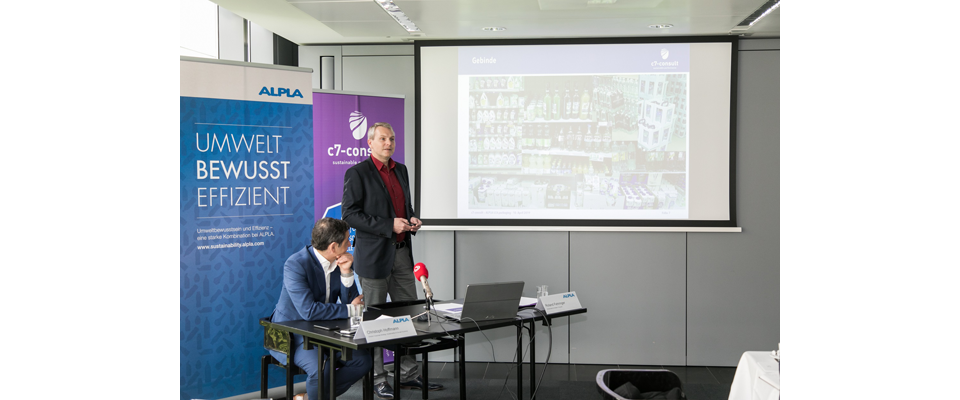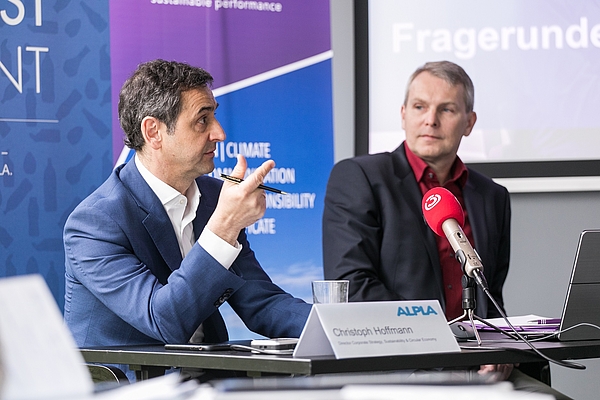

Christoph Hoffmann and Roland Fehringer at the study presentation in Vienna. (Photo credit: Alpla)
Study
New study quantifies the environmental impacts of packaging
ALPLA commissions life cycle assessments – positive effect of plastics recycling is documented. c7-consult tested the environmental impacts of the packaging of various products typical to the Austrian market ranging from beverages to detergents, considering everything from the contribution they make to climate change to their water consumption. The assessments were commissioned by ALPLA. The motivation for the global specialist in packaging solutions based in Vorarlberg was to contribute to making public debate in this area more objective. The study attests to the positive contribution that recycling makes to environmental footprints.

The consultancy company c7-consult produced life cycle assessments for the packaging of eight product categories available in food retail in Austria in accordance with ISO 14044. In all, 59 material-content combinations were tested. Six inventory analysis parameters and seven impact categories were calculated in order to compare the environmental impacts. These range from the contribution made to climate change to water consumption.
‘Debate is currently often very emotionally charged. With this comprehensive study, we are seeking to present the situation more objectively,’ explains Dr Christoph Hoffmann, Director of Corporate Strategy, Sustainability & Circular Economy, at ALPLA. He continues: ‘Industry wants more sustainable packaging solutions and the lawmakers are prescribing higher recycling quotas. The study provides important indications in this respect.’ The last study to be made public in Austria was some time ago: ‘In 2010, the environmental research company IFEU assessed PET and glass bottles used for mineral water and soft drinks,’ explains the study’s author Roland Fehringer.
Fehringer presented examples taken from the life cycle assessments of the packaging of typical brand name products in Austria today in Vienna, such as mineral water, carbonated soft drinks, milk, foods and detergents. In the study, their contribution to climate change, their acidification potential, their contribution to summer smog and their water consumption were presented as the most relevant environmental impacts.

PET out in front of glass for mineral water
In the case of water, a 1-litre reusable glass bottle only performs better than a polyethylene terephthalate (PET) bottle containing no recyclates in the area of climate change. When it comes to acidification potential and summer smog, the PET bottle with no recyclates is already better than the reusable glass bottle. Recyclates in the PET (rPET) then increase the gap between the two considerably. The water consumption of reusable packaging units is 50 per cent higher than that of single-use packaging. ‘In theory, the winner is the reusable PET bottle made of 100 per cent recyclates,’ explains Roland Fehringer
‘However, there is no system for this in Austria and the benefit is limited to climate change, as the single-use bottle made of 100 per cent rPET has a slight advantage over its reusable counterpart when it comes to acidification and summer smog.’ Christoph Hoffmann goes on: ‘We will focus more on reusable systems in the future and will develop practicable solutions in close cooperation with our customers. Reusable solutions developed by ALPLA already exist in a number of markets. However, it is important to consider that there is a lack of adequate acceptance among Austrian consumers of the reusable PET bottle for water and soft drinks, resulting to it being withdrawn from the market. The proportionality of the additional costs and the environmental benefits really needs to be looked into.’ Here too, the single-use glass bottle has the highest environmental impact across the board.
HDPE performs well for milk
For milk, 1-litre bottles made of high-density polyethylene (HDPE) are better environmentally speaking than the alternatives that were tested. Summer smog is the only area in which the single-use bottle made entirely of rPET has less impact than an HDPE bottle containing no rHDPE. The bonded drinks carton has slight advantages over the reusable glass bottle and the 50 per cent rPET bottle. Simpler bonded carton systems than the version tested here can perform even better. The single-use glass bottle has the gravest impact on the environment across all the criteria.
Soft drinks in rPET bottles at the top
In the case of carbonated soft drinks, a 0.5-litre single-use PET bottle containing a maximum of 50 per cent recyclates is slightly behind the reusable glass bottle in terms of its climate change impact. All three of the reusable PET bottles tested and the single-use PET bottle made of 100 per cent rPET perform better than the reusable glass bottle. PET is out in front in terms of the other three environmental impacts, both with and without recyclates, with the single-use PET bottle made of 100 per cent rPET even outperforming the reusable options in terms of environmental impact. The aluminium tin and the single-use glass bottle have significantly higher environmental impacts.
Detergent refill pouches prove to be good for the environment
In the area of detergents, 1.8-litre refill pouches made of polypropylene (PP) proved to be the most environmentally sustainable packaging solution in the study. Not even 1.5-litre PET and HDPE bottles made entirely of recyclates performed so well. According to the study author, only a single-digit percentage of refill pouches are currently recycled, while the rest are incinerated. ‘We see the lack of recyclability as a disadvantage,’ comments Christoph Hoffmann.
PET the clear winner for food
In the area of food, the study analysed a single-use peanut butter jar made of PET, a single-use glass jam jar and a tinplate tin of sweetcorn. For the purposes of fair comparison, the filling volumes ranging from 310 to 420 millilitres were standardised at 350 millilitres. The clear winner was the PET packaging. The single-use glass jar had double the impact on the environment, while the tin can’s impact was even up to seven times higher. The recyclate proportion of the PET packaging units has a positive effect, albeit not as pronounced as that of beverages as the amount of transport packaging needed for these small packaging units is relatively high.

Study summary
With the exception of the food category, in which the tinplate tin performed the worst, the single-use glass bottle is the least environmental packaging unit of all the material-content combinations tested. The aluminium tin is almost always the runner-up to plastic packaging in the uses tested, but finishes ahead of single-use glass. In the case of water and soft drinks, the reusable PET bottle should be marginally favoured in terms of its climate change impact, while the single-use PET bottle made of 100 per cent rPET is in front in terms of the other environmental impacts. No clear distinction can be made between the performance of reusable glass and single-use PET with no recyclates in Austria. Increasing the proportion of recyclates in plastic bottles certainly reduces the environmental impact, thus putting these plastic bottles ahead of the reusable glass bottle.
‘These results are of great value both to us and our customers in order for us to make the right decisions when it comes to developing sustainable packaging solutions,’ explains Christoph Hoffmann.
Study criteria
The study covers the manufacture of packaging units, closures, labels, sales and transport packaging, the filling and cleaning of reusable packaging units, delivery to the food retailers and the return delivery of reusable packaging units, other examples of transport such as the delivery of raw materials, packaging units and closures for the filling process, separate collection of the packaging units or collection as part of domestic refuse, and material recycling and energy recovery.
The study does not cover the manufacture of the packaging contents, losses during transport and storage, the consumers’ journeys to the retailer, the cooling process at home, losses due to damaged packaging and possible differences in the shelf lives of the various packaging systems.
All the packaging units available in Austrian food retail were purchased by c7-consult and the packaging, closures and labels were weighed. Data regarding sales and transport packaging, transport distances, and energy and water consumption during the filling process is confidential information from the beverages industry and from previous c7-consult analyses. The environmental database Ecoinvent 3.5 was used for conversions to the impact categories and inventory analysis parameters. Critical parameters of relevance to the results such as the number of reusable packaging units in circulation, the distribution distance to the food retailers, the volume of bonded drinks cartons for milk, the proportion of secondary materials in aluminium tins and the collection and recycling quotas in Austria were examined and evaluated in the sensitivity analysis. The results of the life cycle assessments were confirmed in the subsequent peer review performed by Harald Pilz of to4to.
More information:
- Sustainability at ALPLA: https://sustainability.alpla.com/de
- Study author’s website: https://www.c7-consult.at/
- Peer reviewer’s website: http://www.to4to.at/
The comPETence center provides your organisation with a dynamic, cost effective way to promote your products and services.

magazine
Find our premium articles, interviews, reports and more
in 3 issues in 2025.







